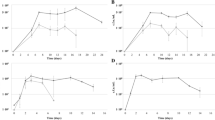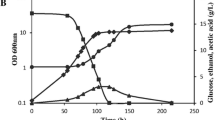Abstract
The capacity to produce 2,3-butanediol by 90 strains of four different species of wine yeasts (Kloeckera apiculata, Saccharomyces cerevisiae, Saccharomycodes ludwigii, Zygosaccharomyces bailii) was tested in grape must by automated multiple development HPTLC. The total amount of 2,3-butanediol produced varied between 23mg l−1 and 857.7mg l−1 according to the yeast species. S. cerevisiae and Z. bailii behaved similarly, producing elevated amounts of 2,3-butanediol. K. apiculata and Sc. ludwigii, in contrast, were low producers. When considerable amounts of 2,3-butanediol were found, little acetoin was present; the amounts of butanediol and acetoin were characteristic of the individual species.
Similar content being viewed by others
References
Antonelli, A. 1994 Ethanol determination by packed GLC: a quick method with small sample amounts and high sensitivity. WeinWissenschaft 49, 165–167.
Benda, I. 1982 Wine and brandy. In Prescott and Dunn's Industrial Microbiology, ed Reed, G. pp. 293–402. Westport: Avi. Publ. Comp.
Brandolini, V., Menziani, E., Mazzotta, D., Cabras, P., Tosi, B. & Lodi, G. 1993 Characterization of sugars in beer by AMD–HPTLC system. In Proceedings of `Progress in Food Fermentation', ed Morell, J. pp. 473–478. Valencia, Spain.
Brandolini, V., Menziani, E., Mazzotta, D., Cabras, P., Tosi, B. & Lodi, G. 1995 Use of AMD-HPTLC for carbohydrate monitoring in beers. Journal of Food Composition and Analysis 8, 336–343.
Dubois, P. 1994 Les aromes des vins et leurs défauts. Revue Francaise d'Oenologie 145, 27–40.
Herold, B, Pfeiffer, P. & Radler, F. 1995 Determination of the three isomers of 2,3-butanediol formed by yeasts or lactic acid bacteria during fermentation. American Journal of Enology and Viticulture 46, 134–137.
Herraiz, T., Reglero, G., Herraiz, M., Martin-Alvarez, P.J. & Cabezudo, M.D. 1990 The influence of the yeast and type of culture on the volatile composition of wines fermented without sulfur dioxide. American Journal of Enology and Viticulture 41, 313–318.
Houtman, A.C., Marais, J. & Du Plessis, C.S. 1980 Factors affecting the reproducibility of fermentation of grape juice and of the aroma composition of wines. I. Grapes maturity, sugar, inoculum concentration, aeration, juice turbidity and ergosterol. Vitis 19, 37–54.
Lodi, G., Betti, A., Menziani, E., Brandolini, V. & Tosi, B. 1991 Some aspects and examples of automated multiple development (AMD) optimization. Journal of Planar Chromatography 4, 106–110.
Lodi, G., Betti, A., Brandolini, V., Menziani, E. & Tosi, B. 1994 Automated Multiple Development/High Performance Thin Layer Chromatographic analysis of sugar on hydrophilic layers: I. Journal of Planar Chromatography 7, 29–33.
Lodi, G., Bighi, G., Brandolini, V., Menziani, E., & Tosi, B. 1997 Automated Multiple Development HPTLC analysis of sugar on hydrophilic layers: II diol layers. Journal of Planar Chromatography 10, 31–37.
Marchese, R. & Romano, P. 1997 Influence of yeast strain character ``acetoin production'' on the formation of by-products in beer fermentation. Alcologia, 9(2), 133–135.
Marchese, R., Romano, P., Debourg, A. & Van Nedervelde, L. 1997 Acetoin reductase activity as selection character in Saccharomyces cerevisiae strains for industrial applications. In Proceedings of the 18th ISSY `Yeast Nutrition and Natural Habitats', pp. P9–01, Bled (Slovenia).
Romano, P. & Suzzi, G. 1993 Acetoin production by Saccharomyces cerevisiae wine yeasts. FEMS Microbiology Letters 108, 23–26.
Romano, P. & Suzzi, G. 1996 Minireview: origin and production of acetoin during wine yeast fermentation. Applied and Environmental Microbiology 62, 309–315.
Romano, P., Suzzi, G., Mortimer, R. & Polsinelli, M. 1995 Production of high levels of acetoin in Saccharomyces cerevisiae wine yeasts is a recessive trait. Journal of Applied Bacteriology 78, 169–174.
Romano, P., Suzzi, G., Domizio, P. & Fatichenti, F. 1996a Secondary products formation as a tool for discriminating non-Saccharomyces wine strains. Antonie van Leeuwenhoek 71, 239–242.
Romano, P., Suzzi, G., Brandolini, V., Menziani, E. & Domizio, P. 1996b Determination of 2,3-butanediol in high and low acetoin producers of Saccharomyces cerevisiae wine yeasts by automated multiple development (AMD). Letters in Applied Microbiology 22, 299–302.
Shinohara, T. 1984 L'importance des substances volatiles du vin. Formation et effects sur la qualité. Bullettin de l'Office International du Vin 641-642, 606–618.
Sponholz, W.R., Dittrich, H.H. & Muno, H. 1993 Diols in wine. Viticultural and Enological Science 49, 23–26.
Author information
Authors and Affiliations
Rights and permissions
About this article
Cite this article
Romano, P., Brandolini, V., Ansaloni, C. et al. The production of 2,3-butanediol as a differentiating character in wine yeasts. World Journal of Microbiology and Biotechnology 14, 649–653 (1998). https://doi.org/10.1023/A:1008804801778
Issue Date:
DOI: https://doi.org/10.1023/A:1008804801778




